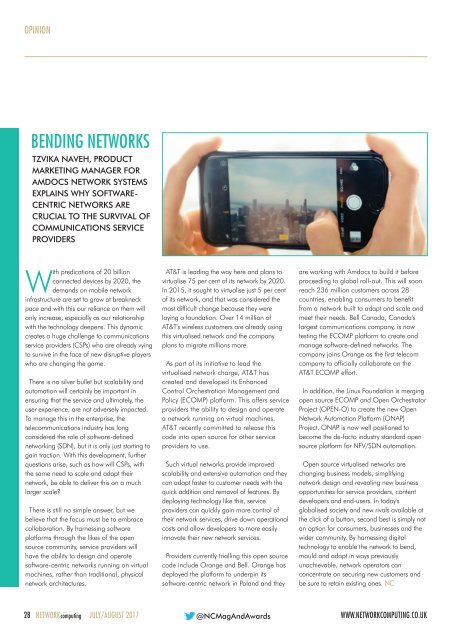You also want an ePaper? Increase the reach of your titles
YUMPU automatically turns print PDFs into web optimized ePapers that Google loves.
OPINION<br />
BENDING NETWORKS<br />
TZVIKA NAVEH, PRODUCT<br />
MARKETING MANAGER FOR<br />
AMDOCS NETWORK SYSTEMS<br />
EXPLAINS WHY SOFTWARE-<br />
CENTRIC NETWORKS ARE<br />
CRUCIAL TO THE SURVIVAL OF<br />
COMMUNICATIONS SERVICE<br />
PROVIDERS<br />
With predications of 20 billion<br />
connected devices by 2020, the<br />
demands on mobile network<br />
infrastructure are set to grow at breakneck<br />
pace and with this our reliance on them will<br />
only increase, especially as our relationship<br />
with the technology deepens. This dynamic<br />
creates a huge challenge to communications<br />
service providers (CSPs) who are already vying<br />
to survive in the face of new disruptive players<br />
who are changing the game.<br />
There is no silver bullet but scalability and<br />
automation will certainly be important in<br />
ensuring that the service and ultimately, the<br />
user experience, are not adversely impacted.<br />
To manage this in the enterprise, the<br />
telecommunications industry has long<br />
considered the role of software-defined<br />
networking (SDN), but it is only just starting to<br />
gain traction. With this development, further<br />
questions arise, such as how will CSPs, with<br />
the same need to scale and adapt their<br />
network, be able to deliver this on a much<br />
larger scale?<br />
There is still no simple answer, but we<br />
believe that the focus must be to embrace<br />
collaboration. By harnessing software<br />
platforms through the likes of the open<br />
source community, service providers will<br />
have the ability to design and operate<br />
software-centric networks running on virtual<br />
machines, rather than traditional, physical<br />
network architectures.<br />
AT&T is leading the way here and plans to<br />
virtualise 75 per cent of its network by 2020.<br />
In 2015, it sought to virtualise just 5 per cent<br />
of its network, and that was considered the<br />
most difficult change because they were<br />
laying a foundation. Over 14 million of<br />
AT&T's wireless customers are already using<br />
this virtualised network and the company<br />
plans to migrate millions more.<br />
As part of its initiative to lead the<br />
virtualised network charge, AT&T has<br />
created and developed its Enhanced<br />
Control Orchestration Management and<br />
Policy (ECOMP) platform. This offers service<br />
providers the ability to design and operate<br />
a network running on virtual machines.<br />
AT&T recently committed to release this<br />
code into open source for other service<br />
providers to use.<br />
Such virtual networks provide improved<br />
scalability and extensive automation and they<br />
can adapt faster to customer needs with the<br />
quick addition and removal of features. By<br />
deploying technology like this, service<br />
providers can quickly gain more control of<br />
their network services, drive down operational<br />
costs and allow developers to more easily<br />
innovate their new network services.<br />
Providers currently trialling this open source<br />
code include Orange and Bell. Orange has<br />
deployed the platform to underpin its<br />
software-centric network in Poland and they<br />
are working with Amdocs to build it before<br />
proceeding to global roll-out. This will soon<br />
reach 236 million customers across 28<br />
countries, enabling consumers to benefit<br />
from a network built to adapt and scale and<br />
meet their needs. Bell Canada, Canada's<br />
largest communications company, is now<br />
testing the ECOMP platform to create and<br />
manage software-defined networks. The<br />
company joins Orange as the first telecom<br />
company to officially collaborate on the<br />
AT&T ECOMP effort.<br />
In addition, the Linux Foundation is merging<br />
open source ECOMP and Open Orchestrator<br />
Project (OPEN-O) to create the new Open<br />
Network Automation Platform (ONAP)<br />
Project. ONAP is now well positioned to<br />
become the de-facto industry standard open<br />
source platform for NFV/SDN automation.<br />
Open source virtualised networks are<br />
changing business models, simplifying<br />
network design and revealing new business<br />
opportunities for service providers, content<br />
developers and end-users. In today's<br />
globalised society and new rivals available at<br />
the click of a button, second best is simply not<br />
an option for consumers, businesses and the<br />
wider community. By harnessing digital<br />
technology to enable the network to bend,<br />
mould and adapt in ways previously<br />
unachievable, network operators can<br />
concentrate on securing new customers and<br />
be sure to retain existing ones. NC<br />
28 NETWORKcomputing JULY/AUGUST 2017 @NCMagAndAwards<br />
WWW.NETWORKCOMPUTING.CO.UK

















